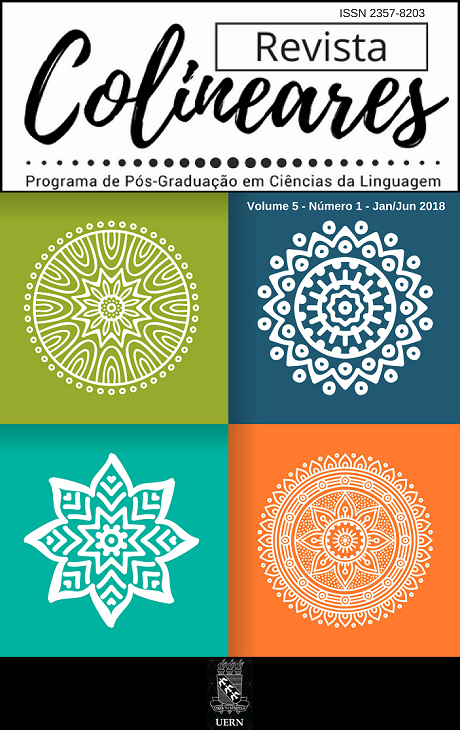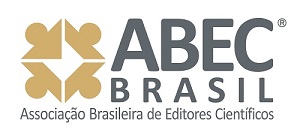OS TERMOS "˜INTERFERÊNCIA"™ E "˜TRANSFERÊNCIA LINGUÍSTICA"™ NA ÁREA DE AQUISIÇÃO DE LÍNGUAS ADICIONAIS: UMA DISCUSSÃO SOBRE SUAS DIFERENTES ACEPÇÕES
Palavras-chave:
Transferência linguística, Sistemas Adaptativos Complexos, Influência translinguísticaResumo
O presente artigo visa a discutir os termos 'interferência' e 'transferência interlinguística', bem como promover um perpassar histórico acerca do desenvolvimento da definição teórica de transferência linguística, desde Weinreich (1953) e Lado (1957) até alcançar a noção de influência sob a perspectiva de língua como Sistema Adaptativo Complexo (RINGBOM, 1985; CENOZ, 2001; HERDINA; JESSNER, 2002; JESSNER, 2008; BRITO, 2011). O termo "˜interferência"™ foi rejeitado (GASS; SELINKER, 1992; CORDER, 1992; ORTEGA, 2009), por indicar um sentido negativo de intervenção da língua materna no desenvolvimento de uma dada "˜língua-alvo"™. Já sob uma concepção de língua como Sistema Adaptativo Complexo, o termo "˜transferência"™ é frequentemente chamado de "˜influência interlinguística"™, sendo visto como um fenômeno que exerce efeitos de uma língua na outra, a partir da possibilidade de múltiplas relações entre os subsistemas envolvidos (L1, L2 e L3), sendo considerado um fator característico do próprio sistema multilíngue (RINGBOM, 1985; CENOZ, 2001; HERDINA; JESSNER, 2002; KUPSKE, 2016; PEREYRON, 2017; de LOS SANTOS, 2018). Ademais, serão discutidos, sob a perspectiva teórica aqui adotada, fatores como a tipologia linguística e proficiência linguística como agentes condicionadores de influência. Finalmente, ao tomar como foco, mais especificamente, o processo de desenvolvimento do componente fonético-fonológico, o presente artigo oferece uma proposta quanto ao termo "˜transferência"™ com base em LarsenFreeman (2015), quem assegura envolver muito mais do que o mero fenômeno de transferir elementos no desenvolvimento linguístico de um aprendiz, a autora afirma que o processo envolve criatividade, inovação, recombinação.
Downloads
Referências
BECKNER, C.; BLYTHE, R.; BYBEE, J.; CHRISTIANSEN, M.; CROFT, W.; ELLIS, N.; HOLLAND, J.; KE, J.; LARSEN-FREEMAN, D.; SCHOENEMANN, T. Language is a Complex Adaptive System: Position Paper. Language Learning, v. 59, n. 1, 2009. p. 1-26.
BEST, K.; TYLER, M. D. Nonnative and second-language speech perception: Commonalities and complementarities. In: MUNRO, M. J.; BOHN, O. S. (Eds.). Second language speech learning: The role of language experience in speech perception and production. Amsterdam: John Benjamins Publishing Company, 2007. p. 13-34.
BIALYSTOK, E.; BARAC, R. Cognitive affects. In: GROSJEAN, F. & LI, P. The psycholinguistics of Bilingualism. Hoboken: Wiley, 2013. p. 192-213.
BLANK, C.A. A transferência grafo-fônico-fonológica L2 (francês) – L3 (inglês): um estudo conexionista. Dissertação (Mestrado em Letras). Pelotas: Universidade Católica de Pelotas. 2008.
______. A influência grafo-fônico-fonológica na produção oral e no processamento de priming em multilíngues: uma perspectiva dinâmica. Tese (Doutorado em Letras). Universidade Católica de Pelotas, Pelotas. 2013.
BLOOMFIELD, L. Language. New York: Holt, Rinehart, and Wintson, 1945.
BRITO, K. S. Influências interlinguísticas na mente multilíngue: Perspectivas psicolinguísticas e (psico)tipológicas. Tese (Doutorado em Letras). Curitiba: Universidade Federal do Paraná. 2011.
CENOZ, J. The Effect of Linguistic Distance, L2 Status and Age on Cross-linguistic Influence in Third Language Acquisition. In: CENOZ, J.; HUFEISEN, B.; JESSNER, U. Cross-linguistic Influence in Third Language Acquisition: Psycholinguistic Perspectives. Multilingual Matters. Bristol: Multilingual matters, 2001. p. 8-20.
DE BOT, K. The Multilingual Lexicon: Modelling Selection and Control. International Journal of Multilingualism, v.1, n. 1, 2004, p. 17-32.
______. Complexity Theory and Dynamic Systems Theory: Same or different? In: ORTEGA, L.; HAN, Z. (eds.) Complexity Theory and Language Development. Amsterdam: John Benjamins Publishing Company, 2017. p. 51-58.
DE BOT, K.; LOWIE, W.; VERSPOOR, M. (2007) A Dynamic System Theory approach to second language acquisition. Bilingualism: Language and Cognition, v. 10, n. 1, p. 7-21.
DE LOS SANTOS, B. R. A produção da vogal átona final /e/ por porto-algrenses aprendizes de espanhol como segunda língua (LA): uma investigação sobre atrito linguístico em ambiente de LA não-dominante. Dissertação (Mestrado em Letras) Porto Alegre, Universidade Federal do Rio Grande do Sul. 2017.
DEWAELE, J-M. Lexical inventions: French interlanguage as L2 versus L3. Applied Linguistics, v. 19, n. 4,1998, p. 471-490.
ELLIS, N. The Emergence of Language as a Complex Adaptive System. In: SIMPSON, J. (ed.). Routledge Handbook of Applied Linguistics. Amsterdam: Abingdon: Routledge/Taylor Francis, 2011. p. 654-667.
FLEGE, J. E. Second Language Speech Learning: Theory, Findings, and Problems. In: STRANGE, W. (ed.) Speech perception and linguistic experience: issues in cross language research. Timonium, MD: York press, 1995.
FRANCESCHINI, R. Sprachadoption: der Einfluss von Minderheitensprachen auf die Mehrheit, oder: Welche Kompetenzen der Minderheitensprachen haben Minderheitensprachen? Bulletin Suisse de Linguistique Appliquée, v. 69, n. 2. 1999.
FRIES, C. Teaching and Learning English as Foreign Language. Ann Arbor: University of Michigan press, 1945.
GALLARDO DEL PUERTO, F. Is L3 Phonological Competence Affected by the Learner"™s Level of Bilingualism? International Journal of Multilingualism, v. 4, n. 1, 2007, p. 1-16.
GASS, S. M.; SELINKER, L. Introduction. In: GASS, S. M.; SELINKER, L. (eds). Language Transfer in Language Learning. Amsterdam: John Benjamins B. V., 1992.
GREEN, D. W. Control, activation, and resource: A framework and a model for the control of speech in bilinguals. Brain and Language, v. 27, n. 2, 1986/1998, p. 210- 223.
GROJEAN, F. (2013) Introduction. In: GROSJEAN, F. & LI, P. The psycholinguistics of Bilingualism. Hoboken: Wiley-Blackwell, 2013.
______; LI, P. (2013). The psycholinguistics of Bilingualism. Hoboken: WileyBlackwell, 2013.
______; PY; B. La restructuration d"™une première langue: l"™intégration de variants de contact dans la competence de migrants bilingues. La Linguistique, v. 23, 1991, p. 35-60.
HAMMARBERG, B. Roles of L1 and L2 in L3 production and acquisition. In: CENOZ, J; HUFEISEN, B; JESSNER, U. (eds.) Cross-linguistic Influence in Third Language Acquisition: Psycholinguistic Perspectives. Bristol: Multilingual matters, 2001. p. 21-41.
HERDINA, P.; JESSNER, U. A Dynamical Model of Multilingualism: Perspectives of Change in Psycholinguistics. Bristol: Cromwell Press Ltd., 2002.
JESSNER, U. Teaching third languages: Findings, trends and challenges. Language Teaching, v. 41, n. 1, 2008. p. 15-58.
KUPSKE, F. F.. Imigração, atrito e complexidade: a produção das oclusivas iniciais surdas do inglês e do português por sul-brasileiros residentes em Londres. Tese (Doutorado em Letras), Porto Alegre: Universidade Federal do Rio Grande do Sul. 2016.
LADO, R. Linguistics across cultures: applied linguistics for languages teachers. Michigan: University of Michigan Press, 1957.
LARSEN-FREEMAN, D. Chaos/Complexity Science and Second Language Acquisition. Applied Linguistics, v.18, n. 2, 1997, p. 141-165.
______. Complex, dynamics systems: A new transdisciplinary theme for applied linguistics? Language Teaching, v. 45, n. 2, 2011, p. 1-13.
______. Complexity Theory. In: VANPATTEN, B.; WILLIAMS, J. (eds).Theories in Second Language Acquisition: An introduction. Amsterdam: Routledge/Taylor Francis, 2015. p. 227-244.
LENNERBERG, E. Biological Foundations of Language. New York: Wiley, 1967.
MERCER, S. Understanding learner agency as a complex dynamic system. System, v. 39, 2011, p. 427-436.
ODLIN, T. Language Transfer: cross-linguistic influence in language learning. Cambridge: Cambridge University Press, 1989.
OLSEN, S. Errors and compensatory strategies: A study of grammar and vocabulary in texts written by Norwegian learners of English. System, v. 27, n. 2, 1999, p. 191- 200.
ORTEGA, L. Understanding Second Language Acquisition. Oxford: Hachette UH Company, 2009.
PENFIELD, W.; ROBERTS, L. Speech and Brain Mechanisms. Princeton: Princeton University Press, 1959.
PENFIELD, W. Conditioning the uncommited cortex for language learning. Brain. Oxford: Oxford University Press, 1965. p. 787-798.
PEREYRON, L. A produção vocálica por falantes de espanhol (L1), inglês (L2) e português (L3): uma perspectiva dinâmica na (multi) direcionalidade da transferência linguística. Tese (Doutorado em Letras). Porto Alegre, Universidade Federal do Rio Grande do Sul, 2017.
RICHARDS, J. C. (1970) A Non-Contrastive Approach to Error Analysis. ELT journal, v. 25, n. 3, 1970, p. 204-219.
RINGBOM, H. The Influence of Swedish on the English of Finnish Learners, Eric, 1985, p. 39-71.
ROSSI, S. (2006) L´interference lexicale dans l´acquisition d´une troisieme langue: effetlangue seconde ou distance typologique? Dissertação (Mestrado em Letras). Galgary, University of Galgary, 2006.
SELINKER, L. Interlanguage. International Review of Applied Linguistics, v.10, n.3, 1972, p. 209-231.
SCHERESCHEWSKY, L. C.; ALVES, U. K.; KUPSKE, F.F. First language attrition: the effects of English (L2) on Brazilian Portuguese Vot patterns in an L1-dominant environment. Letrônica, v.10, n. 2, 2017, p. 700-716.
SCHERESCHESKY, L. C. O atrito linguístico sobre os padrões de VOT do português: efeitos do inglês (L2) e do alemão (L3) em aprendizes bilíngues e trilíngues. Trabalho de Conclusão de Curso (Letras). Porto Alegre: Universidade Federal do Rio Grande do Sul, 2018.
VAN HELL, J.G.; TANNER, D. Second Language Proficiency and Cross-Language Lexical Activation. Language Learning, v.62, 2012, p. 148-171.
VANPATTEN, B. What is second language acquisition and what is doing in this department? ADFLBulletin, v. 30, n. 30, 1999, p. 49-53.
WALTER, C. (2007) First- to second-language reading comprehension: Not transfer, but access. International Journal of Applied Linguistics, v. 17, n.1, 2007, p. 14-37.
WEINREICH, U. Languages in Contact. The Hague: Mouton, 1953/1964. WUNDER, E.M. Phonological Cross-linguistic Influence in Third or Additional Language Acquisition. 6th New Sounds, 2010.
Downloads
Publicado
Como Citar
Edição
Seção
Licença
Copyright (c) 2018 Letícia Pereyron

Este trabalho está licenciado sob uma licença Creative Commons Attribution-NonCommercial-ShareAlike 4.0 International License.






